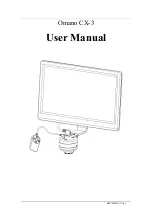
Instruction Manual
Section 10: Calibration
LIQ-MAN-56
April 2017
Calibration
77
10.4
Contacting Conductivity Calibration
New conductivity sensors rarely need calibration. The cell constant printed on the label is
sufficiently accurate for most applications.
CALIBRATING AN IN-SERVICE CONDUCTIVITY SENSOR
After a conductivity sensor has been in service for a period of time, recalibration august be
necessary. There are three ways to calibrate a sensor.
a. Use a standard instrument and sensor to measure the conductivity of the process stream. It is
not necessary to remove the sensor from the process piping. The temperature correction
used by the standard instrument august not exactly match the temperature correction used
by the 56. To avoid errors, turn off temperature correction in both the analyzer and the
standard instrument.
b. Place the sensor in a solution of known conductivity and make the analyzer reading
match the conductivity of the standard solution. Use this method if the sensor can be
easily removed from the process piping and a standard is available. Be careful using
standard solutions having conductivity less than 100 µS/cm. Low conductivity
standards are highly susceptible to atmospheric contamination. Avoid calibrating
sensors with 0.01/cm cell constants against conductivity standards having conductivity
greater than 100 µS/cm. The resistance of these solutions august be too low for an
accurate measurement. Calibrate sensors with 0.01/cm cell constant using method c.
c. To calibrate a 0.01/cm sensor, check it against a standard instrument and 0.01/cm
sensor while both sensors are measuring water having a conductivity between 5 and 10
µS/cm. To avoid drift caused by absorption of atmospheric carbon dioxide, saturate the
sample with air before making the measurements. To ensure adequate flow past the
sensor during calibration, take the sample downstream from the sensor. For best
results, use a flow-through standard cell. If the process temperature is much different
from ambient, keep connecting lines short and insulate the flow cell.
To calibrate the conductivity loop with a connected contacting conductivity sensor, access
the Calibration screen by pressing ENTER/MENU from the main screen, select S1 or S2
Measurement and press ENTER/MENU. Press INFO at any time to learn more about this
procedure. A yellow screen will appear with detailed instructions and information.
The following calibration routines are covered:
1. Zero Cal Zero the analyzer with the sensor attached
2. In Process Cal Standardize the sensor
to a known conductivity
3. Cell K: 1.00000/cm Enter the cell
Constant for the sensor
4. Meter Cal Calibrate the analyzer to a
lab conductivity instrument
5. Cal Factor: 0.95000/cm Enter the Cal
Factor for 4-Electrode sensors from
the sensor tag
Содержание Rosemount 56
Страница 1: ...Instruction Manual LIQ MAN 56 Rev D April 2017 Rosemount 56 Advanced Dual Input Analyzer ...
Страница 2: ......
Страница 10: ...iv Table of Contents Instruction Manual April 2017 LIQ MAN 56 ...
Страница 30: ...Section 2 Installation Instruction Manual April 2017 LIQ MAN 56 20 Installation ...
Страница 40: ...30 Wiring Section 3 Wiring Instruction Manual April 2017 LIQ MAN 56 ...
Страница 64: ...Section 6 Programming Measurements Instruction Manual April 2017 LIQ MAN 56 54 ...
Страница 76: ...Section 8 Time Proportional Control Instruction Manual April 2017 LIQ MAN 56 66 ...
Страница 124: ...Section 13 Maintenance Instruction Manual April 2017 LIQ MAN 56 114 ...
Страница 126: ...Section 14 Return of Material Instruction Manual April 2017 LIQ MAN 56 116 ...
















































